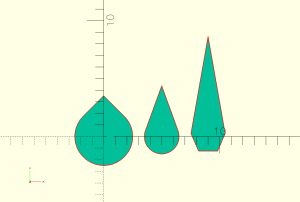« OpenSCAD : LOL-SCAD » : différence entre les versions
Aller à la navigation
Aller à la recherche
| Ligne 30 : | Ligne 30 : | ||
==== Code de la fonction ==== | ==== Code de la fonction ==== | ||
<syntaxhighlight lang="openscad" line="1"> | <syntaxhighlight lang="openscad" line="1" start="1"> | ||
function teardrop(d,a,fn)=let ( | function teardrop(d,a,fn)=let ( | ||
d=d==undef?10:d, | d=d==undef?10:d, | ||
| Ligne 44 : | Ligne 44 : | ||
==== Exemple ==== | ==== Exemple ==== | ||
<syntaxhighlight lang="openscad" line="1"> | <syntaxhighlight lang="openscad" line="1" start="1"> | ||
teardrop(d=5,a=45,fn=32); | teardrop(d=5,a=45,fn=32); | ||
tear= teardrop(d=3,a=20,fn=32); | tear= teardrop(d=3,a=20,fn=32); | ||
Version du 1 octobre 2025 à 16:26
Le but de LOLScad est de permettre l'utilisation de formes en tant que variable afin de permettre de nouvelles formes et transformations.
Cela change en profondeur la manière d'utiliser OpenSCAD. Par exemple, pour faire un carré :
Avant
square([3,4],center=true);
Après
moncarre = square([3,4],center=true);
2D(moncarre);
La différence ?
Si vous réalisez un echo de la variable moncarre, la console affichera : [[-1.5,-2],[-1.5,2],[1.5,2],[-1.5,2]]
Objets 2D
Tous les objets (y compris ceux d'origine d'OpenSCAD) peuvent être utilisés à la fois en tant que variable qu'en tant
Teardrop
Paramètres
- d : diamètre
- a : angle
- fn : qualité
Code de la fonction
function teardrop(d,a,fn)=let (
d=d==undef?10:d,
a=a==undef?30:a,
h=d*tan(90-a),
fn=fn==undef?16:fn,
courbe= [for(i=[0:fn]) [sin(90-a+(360-(90-a)*2)/fn*i)*d/2,cos(90-a+(360-(90-a)*2)/fn*i)*d/2]],
aa=concat(courbe,[[0,(cos(90-a)*d/2)+h*sin(90-a)/2]],[[sin(90-a)*d/2,cos(90-a)*d/2]])
)
aa;
Exemple
teardrop(d=5,a=45,fn=32);
tear= teardrop(d=3,a=20,fn=32);
tear2= teardrop(d=3,a=10,fn=3);
translate([5,0,0]) 2D(tear);
translate([9,0,0]) 2D(tear2);
echo(tear);